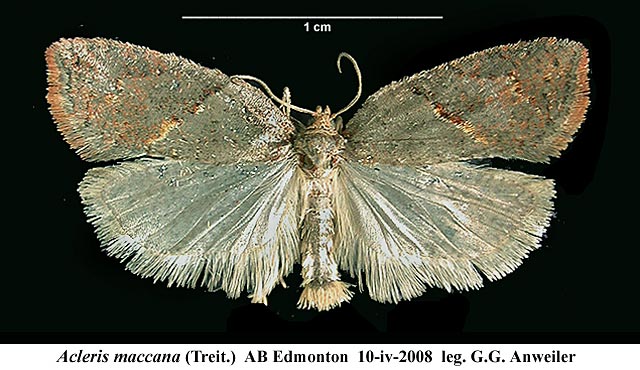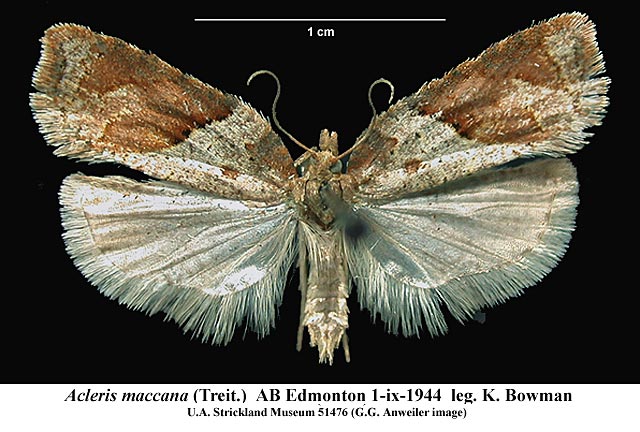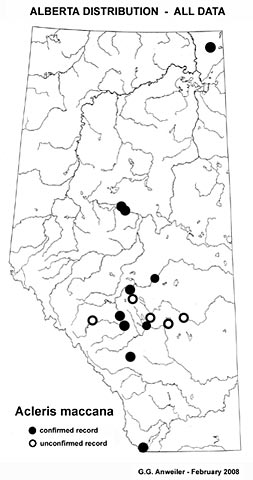Species Details
Acleris maccana
University of Alberta E.H. Strickland Entomological Museum Read more about this collection »
IdentificationA small (approx. 2 cm wingspan) grey-brown or red-brown moth with "squared" wings and the abrupt "shoulder" characteristic of Tortricids. The forewing markings are highly variable. Some specimens (above at right) are poorly marked with markings confined to a narrow oblique rusty red line crossing the forewing midway, and a less prominent erratic line crossing from the midpoint of the costa to the anal angle. Other specimens are grey (lower at right) with the outer half of the wing dark red-brown, frequently with a dark oblique band near the forewing base. Hindwings mottled light brownish grey. The male genitalia (lower right) are quite distinct.
Scientific Name
Acleris maccana
Habitat
Probably occurs in wooded areas throughout the province.
Identification
A small (approx. 2 cm wingspan) grey-brown or red-brown moth with "squared" wings and the abrupt "shoulder" characteristic of Tortricids. The forewing markings are highly variable. Some specimens (above at right) are…
A small (approx. 2 cm wingspan) grey-brown or red-brown moth with "squared" wings and the abrupt "shoulder" characteristic of Tortricids. The forewing markings are highly variable. Some specimens (above at right) are poorly marked with markings confined to a narrow oblique rusty red line crossing the forewing midway, and a less prominent erratic line crossing from the midpoint of the costa to the anal angle. Other specimens are grey (lower at right) with the outer half of the wing dark red-brown, frequently with a dark oblique band near the forewing base. Hindwings mottled light brownish grey. The male genitalia (lower right) are quite distinct.
Life History
Poorly known. Acleris maccana is a solitary leaf roller that feeds on a variety of deciduous trees and shrubs including Myrica, Vaccinium, Rhododendron, Malus, Betula, Salix, Populus and others. The flight period is…
Poorly known. Acleris maccana is a solitary leaf roller that feeds on a variety of deciduous trees and shrubs including Myrica, Vaccinium, Rhododendron, Malus, Betula, Salix, Populus and others. The flight period is late fall (late Aug – early Oct.) and again in early spring (early Apr – mid May), probably hibernating. There is a single annual brood. Adults come to light.
Range
Circumpolar. Europe east across the boreal regions to Siberia; in North America it occurs across much of the boreal forest region, south in the mountains in the east. In Alberta it has been collected from north of Lake…
Circumpolar. Europe east across the boreal regions to Siberia; in North America it occurs across much of the boreal forest region, south in the mountains in the east. In Alberta it has been collected from north of Lake Athabasca (Cornwall Lake) south to Waterton Lakes National Park.
Notes
This little moth is probably widespread and relatively common throughout most of the wooded parts of the province. The late-early flight period possibly contributes to the paucity of collections of adults. Most AB…
This little moth is probably widespread and relatively common throughout most of the wooded parts of the province. The late-early flight period possibly contributes to the paucity of collections of adults. Most AB records are from the old F.I.D.S. rearing records (reported by Prentice as A. fishiana Fern.). The illustrated specimens are from Edmonton; the male genitalic drawing is from Razowski (1966).
References
Author
Bowman, K.
Title
An annotated list of the Lepidoptera of Alberta.
Publication Date
1951
Series Title
Canadian Journal of Zoology
Volume
29
Pages
121-165
Author
Prentice, R. M.
Title
Forest Lepidoptera of Canada. (1965)
Publication Date
1965
Volume
4
Pages
544-840
Author
Razowski, J.
Title
World Fauna of the Tortricini (Lepidoptera, Tortricidae).
Publication Date
1966
Pages
576
Specimen Information
There are 105 specimens of this Species.
UASM51461 - Acleris maccana
University of Alberta E.H. Strickland Entomological Museum
Place CollectedCanada: Alberta, Edmonton
Collected ByBowman, K.
Date Collected1943-10-10
UASM51462 - Acleris maccana
University of Alberta E.H. Strickland Entomological Museum
Place CollectedCanada: Alberta, Edmonton
Collected ByBowman, K.
Date Collected1942-04-24
UASM51463 - Acleris maccana
University of Alberta E.H. Strickland Entomological Museum
Place CollectedCanada: Alberta, Edmonton
Collected ByBowman, K.
Date Collected1942-10-09
UASM51464 - Acleris maccana
University of Alberta E.H. Strickland Entomological Museum
Place CollectedCanada: Alberta, Edmonton
Date Collected1973-04-09
UASM51465 - Acleris maccana
University of Alberta E.H. Strickland Entomological Museum
Place CollectedCanada: Alberta, Edmonton
Collected ByBowman, K.
Date Collected1944-09-22
UASM51466 - Acleris maccana
University of Alberta E.H. Strickland Entomological Museum
Place CollectedCanada: Alberta, Edmonton
Collected ByBowman, K.
Date Collected1935-09-27
UASM51467 - Acleris maccana
University of Alberta E.H. Strickland Entomological Museum
Place CollectedCanada: Alberta, Edmonton
Collected ByBowman, K.
Date Collected1942-09-08
UASM51468 - Acleris maccana
University of Alberta E.H. Strickland Entomological Museum
Place CollectedCanada: Alberta, Edmonton
Collected ByBowman, K.
Date Collected1945-08-30
UASM51469 - Acleris maccana
University of Alberta E.H. Strickland Entomological Museum
Place CollectedCanada: Alberta, Edmonton
Collected ByBowman, K.
Date Collected1945-09-29
UASM51470 - Acleris maccana
University of Alberta E.H. Strickland Entomological Museum
Place CollectedCanada: Alberta, Edmonton
Collected ByBowman, K.
Date Collected1944-09-20
UASM51471 - Acleris maccana
University of Alberta E.H. Strickland Entomological Museum
Place CollectedCanada: Alberta, Edmonton
Collected ByBowman, K.
Date Collected1938-09-07
UASM51472 - Acleris maccana
University of Alberta E.H. Strickland Entomological Museum
Place CollectedCanada: Alberta, Edmonton
Collected ByBowman, K.
Date Collected1940-08-26
UASM51473 - Acleris maccana
University of Alberta E.H. Strickland Entomological Museum
Place CollectedCanada: Alberta, Edmonton
Collected ByBowman, K.
Date Collected1944-09-24
UASM51474 - Acleris maccana
University of Alberta E.H. Strickland Entomological Museum
Place CollectedCanada: Alberta, Edmonton
Collected ByBowman, K.
Date Collected1938-09-14
UASM51475 - Acleris maccana
University of Alberta E.H. Strickland Entomological Museum
Place CollectedCanada: Alberta, Edmonton
Collected ByBowman, K.
Date Collected1944-09-11
UASM51476 - Acleris maccana
University of Alberta E.H. Strickland Entomological Museum
Place CollectedCanada: Alberta, Edmonton
Collected ByBowman, K.
Date Collected1944-09-01
UASM51477 - Acleris maccana
University of Alberta E.H. Strickland Entomological Museum
Place CollectedCanada: Alberta, Edmonton
Collected ByBowman, K.
Date Collected1940-08-24
UASM51478 - Acleris maccana
University of Alberta E.H. Strickland Entomological Museum
Place CollectedCanada: Alberta, Edmonton
Collected ByBowman, K.
Date Collected1927-08-29
UASM51479 - Acleris maccana
University of Alberta E.H. Strickland Entomological Museum
Place CollectedCanada: Alberta, Edmonton
Collected ByBowman, K.
Date Collected1942-09-13
UASM51480 - Acleris maccana
University of Alberta E.H. Strickland Entomological Museum
Place CollectedCanada: Alberta, Edmonton
Collected ByBowman, K.
Date Collected1943-09-07
UASM51481 - Acleris maccana
University of Alberta E.H. Strickland Entomological Museum
Place CollectedCanada: Alberta, Edmonton
Collected ByBowman, K.
Date Collected1942-09-13





